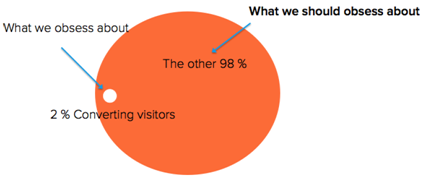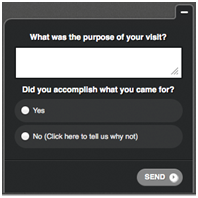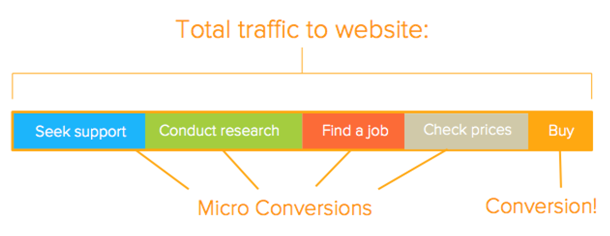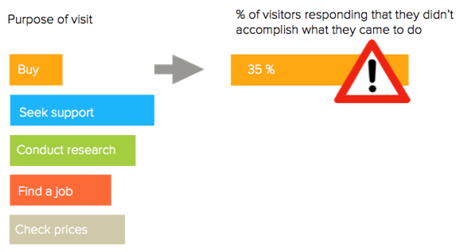According to the February 2015 Forrester (News - Alert) Research Report called Use Customer-Centric Metrics to Benchmark Your Digital Success, “Digital customers use a range of touchpoints in their engagements with your brand, yet only 12 percent of ebusiness professionals feel that their cross-touchpoint measurement is ahead of their peers. Ebusiness professionals must work to prove the value of their digital strategy by benchmarking their success against deeper, customer-centric metrics if they are to drive continued investment in digital transformation.”
Many organizations are myopic in their customer-centric metrics. They are sometimes blinded by the end-all-be-all metric of conversions, which gets in the way of really measuring other customer-centric performance metrics that are vital for nurturing customer engagement and brand affinity. Organizations should be honest in asking themselves if their web presence is enabling customers to accomplish what they came for.
Perhaps you’re working hard on optimizing your call to actions and removing friction from your conversion funnel. Great. But be careful of inundating all your visitors with incentives that are pushing for a conversion, many of them are not interested in at that moment.
So what’s an organization to do? Find out what the remaining 98 percent want to accomplish and incorporate goals and KPIs to track real visitor intent (sometimes the best ideas are the simplest).

Here are some ways to get started.
Ask the Question
Web analytics tells you what happened, not why something happened. So you need to go beyond hunches and get real insights into why people visit your website and what they are trying to accomplish.
There are several great and inexpensive tools that don’t ruin the customer experience and that enable you to survey your visitors’ intent by nudging them to answer a couple of quick questions, right in the moment of interacting with you.

Now, it is absolutely fundamental that you ask strong questions, from which you can drive action. Otherwise you might as well not ask at all.
To get started, it makes sense to only survey your visitors’ highest level intent. For this you need to ask two questions:
What did you come here to do?
Were you successful in accomplishing what you came to do?
Understand Visitor Intent
Once you know why people are on your website, it is your job to figure out the appropriate way to satisfy each main category of visitors. Apart from folks who came with the intention of buying and whom you are obviously looking to convert, you need to find crisp and actionable KPIs for the rest of your visitors.

While this may differ a bit depending on the business that you are in and how your company operates, it is usually effective to break down the intent of the visitor to specific tasks to complete. So in the case of support, your KPI may be the ratio of visitors who are able to solve their issues online, without having to do a channel switch and pick up the phone.
While doing research might mean different things depending on the stage of the visitor and the type of content you offer, you want to make sure that you track the activities that are associated with adding value to your business over the long run. This could be specific events such as the amount of times someone downloads your product brochure or relational events, such as newsletter opt-ins or social media follows.
Once defined, you can steer your content marketing and website development toward improving your audience’s chances to complete their intended tasks. In other words: Every time you invest in new content or in the development of new functionality, you want to make sure you are crisp and honest about which KPI it will improve. If it doesn’t improve a KPI, you shouldn't undertake the activity.
Also, remember to use smart calls to action that respect the intent of your traffic. By way of example, for the folks doing research, skip the push for a macro conversion and focus instead on being clear about the value of opting in for a newsletter or following you on Twitter (News - Alert).
Room to Improve
Your task completion rate is one of the best indicators of where your biggest problems are. If your data shows that of the visitors who came with buying intention, 35 percent were not able to accomplish their task, you know that you need to start generating a hypothesis on how to create a more friction-free buying journey.

Your objective for this buying category will be to fix the impediments so that everyone who is open to converting can do just that. But if this audience bucket contains 20 percent of your total traffic, your true and relevant conversion rate is really the percentage of visitors you convert within those open to convert, not the percentage of visitors you convert of total website traffic.
What’s Next
Unless you are an ostrich putting your head in the sand, there should be ample opportunities to improve the experience for your customers online. Here it is critical to agree on where you are heading and describe what a state of awesomeness would look like. But, you must also very carefully define your next target, one that will (hopefully) also move you toward our goal of awesome.

Make no mistake about it: Everybody is waiting for something. Whatever it is that you are waiting for, don't let it be an excuse for not taking action. Oftentimes surprisingly simple things are holding your visitors back from accomplishing what they came for.
To illustrate that, if 15 percent of your visitors come to find contact information and you are failing to provide it for them, there should be a clear incentive to invest an hour or two to incorporate this information into your footer or header. The faster you go through the cycle of identifying your customers’ issues, executing on improvements and evaluating what works, the better your chances are of being customer centric.
By taking the time and effort to understand what your customers really want to accomplish, you can then incorporate goals and KPIs to track real visitor intent, to achieve the end goal of making your web presence truly customer centric. After all, if 98 percent of your customers want something from you that you are not aware of and not measuring, it’s probably a good idea to start understanding what that is so you can deliver accordingly.
Joakim Holmquist is director of digital marketing at EPiServer (www.episerver.com).
Edited by Dominick Sorrentino

